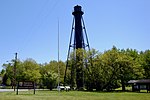William and Margaret Mecum House
1737 establishments in New JerseyBrick buildings and structuresGeorgian architecture in New JerseyHouses completed in 1737Houses in Salem County, New Jersey ... and 5 more
Houses on the National Register of Historic Places in New JerseyNational Register of Historic Places in Salem County, New JerseyNew Jersey Register of Historic PlacesPennsville Township, New JerseyUse mdy dates from August 2023

The William and Margaret Mecum House is located at 168 Lighthouse Road in Pennsville Township of Salem County, New Jersey, United States. Built in 1737, the house was added to the National Register of Historic Places on March 5, 2018, for its significance in architecture. The house is part of the Traditional Patterned Brickwork Buildings in New Jersey Multiple Property Submission (MPS).
Excerpt from the Wikipedia article William and Margaret Mecum House (License: CC BY-SA 3.0, Authors, Images).William and Margaret Mecum House
Lighthouse Road,
Geographical coordinates (GPS) Address Nearby Places Show on map
Geographical coordinates (GPS)
| Latitude | Longitude |
|---|---|
| N 39.616472222222 ° | E -75.523611111111 ° |
Address
Lighthouse Road
Lighthouse Road
08070
New Jersey, United States
Open on Google Maps






